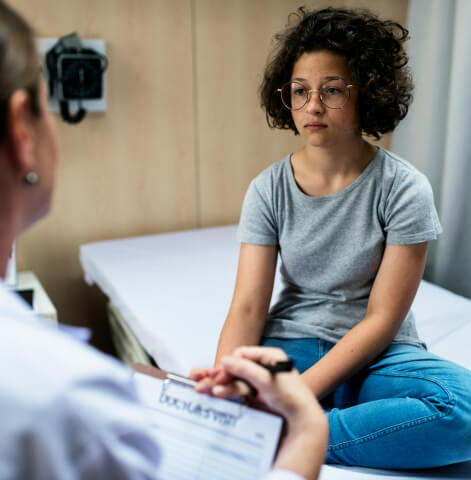January 27, 2025
Pediatric & AYA Melanoma
Understanding the Rising Dangers of Pediatric & AYA Melanoma
Understanding Pediatric & AYA Melanoma.
Melanoma, the most dangerous form of skin cancer, is on the rise in both adults and children. Although pediatric and AYA (adolescent and young adult) melanoma is quite rare, a 2013 study published in the journal Pediatrics indicated that diagnoses are rising in the U.S., particularly in the age group of 15-19 years, by approximately 2% each year.1 The National Cancer Institute estimates that approximately 500 children in America are diagnosed each year. Additionally, a 2015 study published in the Journal of Investigative Dermatology contained a comprehensive genomic analysis of pediatric melanoma – finding unique genomic features for each of the three subtypes (discussed below) of pediatric melanoma – and suggests compelling evidence that UV exposure may play more of a role than initially thought in this disease, primarily regarding conventional pediatric melanoma.2
Most Common Categories of Pediatric Melanoma.
Pediatric melanomas are often divided into three categories:
- Conventional Melanoma (CM): Pediatric CM is rarely diagnosed before puberty. Clinically, CM in younger patients shows several similarities to adult melanoma, including evidence of UV-induced DNA damage and similar UV-induced mutations (such as the BRAF mutation).
- Spitzoid Melanoma (SM): Spitzoid Melanomas are often nodular in nature, round in shape and uniform in color. Therefore, SM does not typically follow the commonly used ABCDE guide to diagnosing melanoma. Additionally, SMs often lack common adult melanoma genetic mutations (such as BRAF or NRAS). When first discovered in 1948 by Sophie Spitz, SMs were described as “melanomas of childhood”.
- Congenital Melanocytic Nevus (CNM): A CNM is a large, pigmented mole or birthmark that is present at birth. Current research suggests approximately 5-10% of CNM cases develop into melanoma.
Ocular melanoma and mucosal melanoma are rare forms of the disease and although uncommon, can also occur in children.

Causes & Risk Factors.
Causes and risk factors for conventional pediatric melanoma (CM) appear to be similar to that of adult melanoma. Children with fair skin, light hair and freckles are at higher risk. Nearly 90% of adult melanomas are thought to be linked to UV exposure. Similarly, current research indicates that CM has genomic similarities to adult melanoma – such as UV-induced DNA damage and UVA-induced mutations. However, some pediatricians and pediatric oncologists are noticing that children with darker pigmented skin and skin that is less sun-sensitive are being diagnosed with melanoma, especially under the age of 13. No clear cause is known for spitzoid melanoma (SM) or congenital melanocytic nevi (CNM). Like adult melanoma, the development of pediatric melanoma, especially SM, is likely a combination of genetic predisposition and other unknown triggers, but no one knows for sure at this time.
Children who have been treated for melanoma are at an increased risk of recurrence later in life, making lifelong skin checks, follow-up with an experienced medical oncologist and other prevention methods very important. It is clear that fighting melanoma must start with prevention efforts, public awareness efforts, behavior modification and attitude changes toward sun safety and overall sun exposure. It’s never too early, or too late, to protect your skin or your child’s skin from harmful UV rays.
Do you have concerns or questions about sunscreen? Learn the facts about sunscreen and be sure to share our educational items with your school and doctor’s office!

AYA Melanoma
Adolescent & Young Adult Melanoma.
Adolescent and young adult, or AYA, refers to someone diagnosed with melanoma between the ages of 15-39. According to the National Cancer Institute, about 70,000 young people (ages 15-39) are diagnosed with cancer each year in the United States – accounting for about 5% of cancer diagnoses in the U.S. Unfortunately, research suggests that AYA patients have not had the same improvements in overall survival that either younger children or older adults have had.
Programs at several major cancer centers are now focusing on helping young adult patients and their families manage the emotional toll of a diagnosis, gain access to clinical trials, understand treatment and possible fertility risks and options, and connect with others who are facing similar issues.
In addition to the cancer-specific differences, AYA patients often have less access to clinical trials and are provided with insufficient, age-appropriate psychosocial support and health services. Improving access to these services may influence survival as well as overall quality of life.
Of great concern is the fact that the incidence of melanoma is largely preventable, yet continues to increase in the AYA population. An estimated 75% of melanomas diagnosed in people younger than 30 years of age appear to be linked to exposure to natural or artificial UV radiation. More must be done to protect skin health, reduce the rate of melanoma diagnoses and increase awareness of melanoma.
Because melanoma is a relatively rare diagnosis, it is important to find an oncologist who specializes in treating melanoma. In addition, a second opinion may be especially helpful when complicated medical decisions need to be made or if there are different treatment options to choose from.

Citations
Content last updated: August 27, 2020
Tricoli JV, Blair DG, Anders CK, et al. Biologic and clinical characteristics of adolescent and young adult cancers: Acute lymphoblastic leukemia, colorectal cancer, breast cancer, melanoma, and sarcoma. Cancer. 2016;122(7):1017-1028. doi:10.1002/cncr.29871






